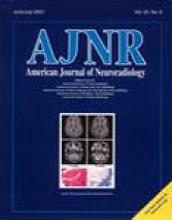Abstract
BACKGROUND AND PURPOSE: An increased incidence of intestinal helminthic infections has been observed in patients with viral encephalitis in endemic areas. Both Japanese B encephalitis (JE) and neurocysticercosis (NCC) share some common socio-demographic and ecologic factors, and pigs act as the intermediate carrier for both. Our purpose was to show the coexistence of JE and NCC in brain on MR images and highlight the possible role of NCC as an amplifier of JE.
METHODS: MR images from 10 cases of coexistent JE and NCC were studied retrospectively. T1-weighted axial and sagittal, proton T2-weighted axial and coronal, and T2-weighted fluid-attenuated inversion recovery axial and coronal sections of the brain were evaluated. NCC was diagnosed on the basis of neuroimaging. Diagnostic serologic testing for JE was conducted using paired blood and CSF samples.
RESULTS: The JE changes were bilateral and asymmetrical and were more severe on the side harboring the solitary cyst or the side bearing the greater number of cysts or lodging the degenerating cyst. In each of nine of 10 cases, at least one degenerating cyst was found on the side of predominant JE pathologic abnormality.
CONCLUSION: The study suggests that the co-occurrence of JE and NCC is not just a chance coincidence. NCC apparently predisposes a person to JE infection and is a positive modulator of the encephalitic process. The study shows a spectrum of MR imaging findings of coexistent JE and NCC.
- Copyright © American Society of Neuroradiology







